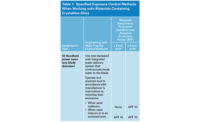Public health experts call the Final Rule Governing Workplace Exposure to Crystalline Silica issued by OSHA last week “a lifesaving public health victory.” Roofers say it will increase fall hazards.
What it will do, for certain, is dramatically reduce the permissible exposure limit for crystalline silica to 50 micrograms per cubic meter of air, averaged over an eight-hour shift. In order to comply with the limit, employers are required to:
- use engineering controls (such as water or ventilation) and work practices to limit worker exposure;
- provide respiratory protection when controls are not able to limit exposures to the permissible level;
- limit access to high exposure areas; train workers; and
- provide medical exams to highly exposed workers.
2.3 million workers affected
OSHA says the rule will curb lung cancer, silicosis, chronic obstructive pulmonary disease and kidney disease among the estimated 2.3 million Americans who are exposed to respirable crystalline silica in their workplaces, which include construction, foundries, glass manufacturing, brick-making facilities and at hydraulic fracking sites.
Although it is still in the process of reviewing the 1,772-page final rule, and it admits that OSHA made “modest improvements” to the regulation in response to stakeholder feedback, the National Roofing Contractors Association (NRCA) says it has “serious concerns” about changes.
Fall hazards on sloped roofs
NRCA CEO William Good said the engineering controls that will have to be implemented are not suited to work performed on sloped roofs, and will significantly increase fall hazards for roofing operations.
“Workers in many cases will have to use wet saws on the rooftop, introducing new hazards such as slipping on wet surfaces and tripping on hoses” said Good, who called on OSHA to help identify implementation strategies that protect workers from fall hazards.
The NRCA is also concerned about compliance costs and the technologically feasibility of accurately measuring workplace silica levels.
On the other hand...
The American Public Health Association (APHA), however, is calling the rule, “enormously good news for public health.”
“We know that silicosis alone kills 200 workers and harms 7,300 more each year,” said APHA Executive Director Georges C. Benjamin.
“Although deaths from acute silicosis have declined since the 1930s, they unfortunately occur to this day, as do illness and death from chronic silicosis, silicotuberculosis, lung cancer, and other diseases we have only recently confirmed to be caused by exposure,” said APHA Occupational Health and Safety Section member Rosemary Sokas, MD, MOH. “The OSHA silica standard, if adequately enforced, should also be a force for reducing health disparities, since occupational silica exposure disproportionately impacts low income, African American and Latino workers.”
Deadlines
The final rule is written as two standards, one for construction and one for general industry and maritime. Employers covered by the construction standard have until June 23, 2017 to comply with most requirements. Employers covered by the general industry and maritime standard have until June 23, 2018 to comply with most requirements; additional time is provided to offer medical exams to some workers and for hydraulic fracturing employers to install dust controls to meet the new exposure limit.
More information is available at https://www.osha.gov/silica/




